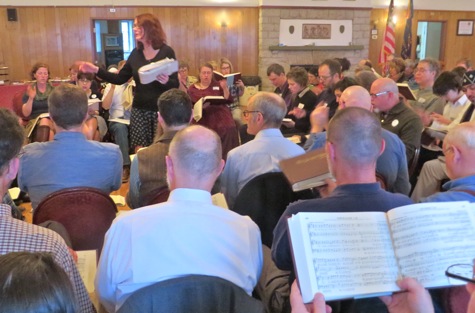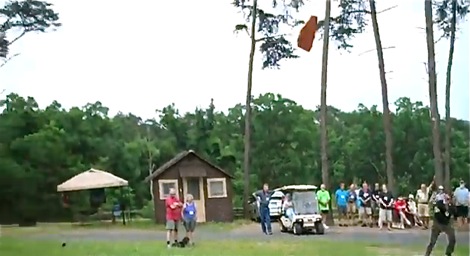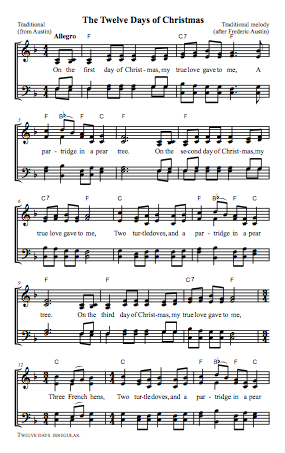45 sec. of video of the taiko drummers at the opening plenary of the Religious Education Association 2014 conference.
Category: Musical arts
Feminist musical spirituality
Anonymous 4 has announced that the 2015-2016 season will be their last. This may not mean anything to you, so I had better explain who the Anonymous 4 are.
Back in the late 1980s, I was living near Boston and listening to a lot of early music. The Boston area at that time was one of the centers of the early music revival in the United States. There was lots of live music, including a renowned early music festival, record stores with entire sections for early music, and a dedicated fan base.
I shared this passion for early music with Joel, one of my housemates at that time. Joel was an amateur musician, a member of the American Recorder Society who got into a master class with internationally-famous recorder virtuoso Marian Verbruggen, and a singer who eventually wound up in a choir that specialized in 13th century Flemish choral music. I was merely a fan, and Carol and I became groupies of that 13th century Flemish music choir (not as risque as it might sound; we just sold tickets at their performances). I tell you this to give you an idea of the early music scene at that time: Marion Verbruggen gave master classes! There was an entire choir devoted to 13th century Flemish music! Early music choirs had groupies!
During the late 1980s, I began to hear about this innovative quartet of women singers called Anonymous 4, who were making recordings of medieval music. Everyone I knew talked about it as kind of feminist endeavor. They explored feminine aspects of medieval sacred music: music by women composers, positive images of women in medieval music. And as progressive as the early music scene tended to be, it was considered mildly radical for women to sing medieval sacred music; there was a common misconception that only medieval men really sang sacred music, but Anonymous 4 helped make it widely known that medieval women also sang sophisticated and beautiful sacred music.
I have to admit I never went to an Anonymous 4 concert until a few years ago. In the late 1980s, when they were singing medieval music, I was more interested in 16th century polyphony and Baroque music. In the 1990s, I drifted away from early music and began listening to new music, and folk and trad music. Yet had I been paying attention, I would have found that Anonymous 4 had already explored these musics: among other projects, they premiered new work by composer Richard Einhorn, and performed with bluegrass fiddler Daryl Anger.
But though I missed their live music, I kept listening to their recordings, as did so many other music aficionados. Their sound is immediately recognizable: the lack of vibrato, the precise intonation, the fluid but disciplined sense of rhythm, the unity of musical purpose; and above all the transcendent beauty of their interpretations of sacred music. In our deeply secular age, not many musicians, not even many church choirs, make you feel that sacred music can be transcendent and holy. For me, Anonymous 4 represent the very best of the revolution in feminist spirituality: they may be a secular ensemble, but they sing sacred music as if it’s sacred; and that is a rare and wonderful thing.
They’re not done yet; they’re working on one more recording, and they’ll be performing for two more seasons. Nevertheless, it feels like the end of an era in feminist spirituality.
The problems of Web casting
Those of us who have looked into Web casting our Sunday services know that it can be tremendously difficult to navigate that new legal landscape. Music poses some especially difficult challenges for Web casting. In the following video, the chaplain at King’s College in England describes one solution to the problem of legal minors appearing on Web casts:
What I did with my weekend

The view from the bass section as a singer from Bremen, Germany, (alas, I didn’t catch her name) named Eva led well over a hundred singers at a Sacred Harp singing convention this past weekend.
What was it like singing with all those people, you ask? I’ll limit myself to the physiological response. With something over thirty singers in the bass section, I could feel my whole body vibrating to the lower notes. And since this is highly rhythmic music, we could also spend time talking about entrainment from an ethnomusicological perspective.
This, by the way, is why you might want to improve congregational singing so that it’s good, rhythmic, and loud — because when you do that, it feels really good.
Pete Seeger: a brief appreciation
When my older sister and I were young, our parents used to play this one record that I liked to try to sing along to: “Pete Seeger at Carnegie Hall.” I loved all the songs on that album: “Little Boxes,” and “We Shall Overcome,” and “Guantanamera,” and “Keep Your Eyes on the Prize.” I can still remember Pete Seeger’s spoken introduction to “If You Miss Me at the Back of the Bus,” when he talks about the violent measures taken against civil rights protesters. I can remember trying to memorize the words to “Little Boxes,” and in the process learning how to be critical of the assumptions undergirding middle class suburban culture, which probably helped lay the intellectual groundwork for my studies of critical theory and Marxism about ten years later, when I was in college. I had already learned from my parents how to be critical of what I was taught in school, but listening to “What Did You Learn in School Today?” made that seem fun and mischievous and delightful, and a few years later when I started working with children the memory of that song gave me a standard by to judge my own efforts as an educator.
Pete Seeger’s greatest strength was his ability to sing for children and young people. He was a teacher as much as, or more than, a musician. When he sang, he taught about big concepts like justice and human rights and racism and social inequality — he taught all these big concepts in a way that a six year old could understand them. His infectious songs and style of singing ensured that the children and young people who heard him sing would remember the lessons he taught for a long, long time. Continue reading “Pete Seeger: a brief appreciation”
Update
I managed to get bronchitis and laryngitis at the same time (I always think it’s amusing when preachers, who make their living by talking, get laryngitis). This slowed me down: I haven’t had much energy for a week, and my brains feel like Swiss cheese.
But I did have enough energy to finally update The Folk Choir Song Book, which was first published in 2009 (when I was coming off two years of directing a folk choir at a UU church). I’ve corrected many typographical errors, removed one song that turned out to be covered by copyright, and added some fun stuff that didn’t make it into the first edition.
Update, 2023: this book is no longer available.
What we do at committee meetings
One of the things we do in committee meetings in our congregation is we wind up talking about other subcultures of which we are a part. Beth, for example, is part of the autoharp subculture. And, said Beth, one of the things they sometimes do at autoharp conventions is they have an autoharp toss. What’s that? we asked. That’s when you take an old autoharp that’s beyond repair, and see how far you can toss it. So we interrupted committee business to watch a Youtube video of autoharp tossing….
When I showed this video to Carol, my partner, she thought it was silly. She’s obviously not a sports fan.
Twelfth day
It’s the twelfth day of Christmas. What to do on the twelfth day of Christmas? You could read Shakespeare’s “Twelfth Night.” Or some family traditions hold that this is the day to take down your Christmas tree.
Or, if you have a certain kind of obsessive personality, you could sing every verse of “The Twelve Days of Christmas.” And, in case you want to engage in this last effort, I’m posting a PDF of sheet music with guitar chords and a SATB/piano accompaniment.
N.B.: The first five verses are written out completely. Then the last page shows all twelve verses, and you’ll have to figure out on your own where to start each new verse.
16 SATB Xmas carols and songs
I’ve added a new Web page with 16 Christmas carols and songs, in basic SATB arrangements (one is STB) — including carols not in the current Unitarian Universalist (UU) hymnals (like “Jingle Bells”), carols with words from older UU hymnals (like “Joy to the World”), etc. You can find the page here.
(Yes, I know Christmas is over for the year. I’ve been meaning to put these online for a couple of years, I never seem to have time to do it before Christmas, so I’m going to put them up now.)
Caroling
Michele, my voice teacher and friend, sent out an invitation to some caroling in her neighborhood. Even though she lives way over in north Berkeley, I decided to go — I didn’t know anyone who was going to go caroling near where we live, and I wasn’t up to organizing caroling on my own.
Close to twenty people gathered in Michele’s living room yesterday evening. We introduced ourselves, and ran through two carols where we thought we might sing some harmony — “Silent Night” and “Deck the Hall.” Fortunately there was another bass there who helped me through “Deck the Hall,” and I was able to help him once or twice in “Silent Night” — it’s always easier to sing your part when there’s someone else singing with you.
We headed out into Michele’s neighborhood. Michele said we would only sing at houses where we could see Christmas decorations. There were half a dozen children with us, and they ran ahead to scope out likely houses. We’d gather on the sidewalk in front of the house, Michele would quietly tell us which carol — “‘Frosty the Snowman,’ page 3 of the packet!” — the kids would ring the doorbell, and as soon as someone showed up, we’d sing.
Some people listened to us while standing indoors; in one case because there were dogs that desperately wanted to get out; in other cases maybe because it’s a little weird to have a score of people standing in front of your house singing. Other people came out and listened. Reactions ranged from politely tolerant to very enthusiastic. One woman, who had a foreign accent (maybe Middle Eastern?), was really very touched by the singing; we sang her another song.
After an hour, we were getting cold, and some of the younger kids were getting a little bit tired. So we all said “Good night!” and “Merry Christmas!” and dispersed into the night; the younger kids probably heading for bed. As for me, I had some errands to run in downtown Berkeley; but I found myself humming Christmas carols all the way home.


